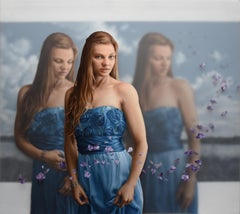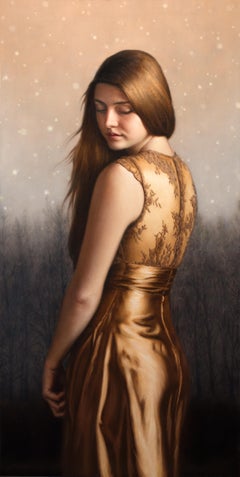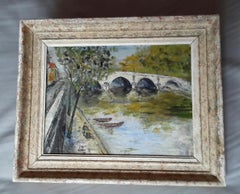Beth Sistrunk Art
to
1
9
5
2
2
3
1
4
1
Overall Height
to
Overall Width
to
8
8
5
5
4
3
3
1
1
1
1
1
9
9
6,958
3,340
2,513
1,213
9
9
1
1
1
Artist: Beth Sistrunk
Songbird
By Beth Sistrunk
Located in Denver, CO
Songbird
Category
21st Century and Contemporary Beth Sistrunk Art
Materials
Oil, Panel
Moose Tracks
By Beth Sistrunk
Located in Denver, CO
Candy with blue clouded background
Category
2010s Beth Sistrunk Art
Materials
Acrylic, Oil
Serenity, Oil Painting
By Beth Sistrunk
Located in Denver, CO
Beth Sistrunk's "Serenity" is an oil on panel featuring a model with pink petals.
About the artist:
Beth's interests in painting the figure, women’s fashion, flowers, landscape phot...
Category
2010s Realist Beth Sistrunk Art
Materials
Oil
Follow Me, Oil Painting
By Beth Sistrunk
Located in Denver, CO
Beth Sistrunk's "Follow Me" is an oil on panel featuring a model with pink petals.
About the artist:
Beth's interests in painting the figure, women’s fashion, flowers, landscape pho...
Category
2010s Realist Beth Sistrunk Art
Materials
Oil
Preoccupation, Oil Painting
By Beth Sistrunk
Located in Denver, CO
Beth Sistrunk's "Preoccupation" is an oil on two translucent acrylic panels featuring a model in a blue dress.
About the artist:
Beth's interests in painting the figure, women’s fa...
Category
2010s Realist Beth Sistrunk Art
Materials
Oil
Twilight, Oil Painting
By Beth Sistrunk
Located in Denver, CO
Beth Sistrunk's "Twilight" is an oil on panel featuring a model at twilight.
About the artist:
Beth's interests in painting the figure, women’s fashion, flowers, landscape photogra...
Category
2010s Realist Beth Sistrunk Art
Materials
Oil
Magnetism, Oil Painting
By Beth Sistrunk
Located in Denver, CO
Beth Sistrunk's "Magnetism" is an oil on two translucent acrylic panels featuring a model with orange petals.
About the artist:
Beth's interests in painting the figure, women’s fas...
Category
2010s Realist Beth Sistrunk Art
Materials
Oil
Vortex, Oil Painting
By Beth Sistrunk
Located in Denver, CO
Beth Sistrunk's "Vortex" is an oil on two translucent acrylic panels featuring a model with red petals.
About the artist:
Beth's interests in painting the figure, women’s fashion, ...
Category
2010s Realist Beth Sistrunk Art
Materials
Oil
Duality, Oil Painting
By Beth Sistrunk
Located in Denver, CO
Beth Sistrunk's "Duality" is an oil on two translucent acrylic panels featuring a model with red petals.
About the artist:
Beth's interests in painting the figure, women’s fashion,...
Category
2010s Realist Beth Sistrunk Art
Materials
Oil
Related Items
French Post Impressionist Bord de Seine Landscape Painting
By Claude Bouteur
Located in Paris, FR
Charming 1940's Claude Bouteur landscape Oil on a wood panel painting in a Post Impressionist style representing the banks of Seine River and the Pont Marie Bridge, a lovely composit...
Category
20th Century Post-Impressionist Beth Sistrunk Art
Materials
Oil, Wood Panel
H 39 in W 46 in D 3 in
Pastoral Country Landscape Travelers on a Forest Road 19th century Oil Painting
Located in Stockholm, SE
Brass plate leads to Russian artist Pavel Pavlovich Dzhogin (1834 - 1885). This 19th century oil painting beautifully captures a serene rural scene with travelers on a cart traveling...
Category
Late 19th Century Realist Beth Sistrunk Art
Materials
Wood, Oil, Wood Panel
Quadriptych Of Fruits, Pocket Sloes, Strawberry, Wild Apple, Pocket Raspberry
By Dani Humberstone
Located in Deddington, GB
Pocket Crimson Strawberry is an original oil painting by Dani Humberstone as part of her Pocket Painting series featuring small scale realistic oil paintings, with a nod to baroque s...
Category
2010s Realist Beth Sistrunk Art
Materials
Canvas, Oil
H 5.91 in W 5.91 in D 1.97 in
Portrait Gentleman Black Coat Orange Sash, Dutch Old Master, Oil on Panel c.1650
By Bartholomeus van der Helst
Located in London, GB
This exquisite portrait of a gentleman depicted in a sumptuous black coat edged with silver and slashed sleeves is an excellent example of the type of portrait fashionable in England and the Low Countries during the 17th century. The confident pose, striking orange sash - the colour of the house of Orange Nassau - and the leather gorget imbue the sitter with a sense of masculinity and power. The profusely decorated costume is of the highest quality and de rigueur of an elite class - the artist has carefully cultivated this portrait to emphasise the sitter’s wealth and standing in the society that he belonged to. The casual pose, with one arm resting on a hip, is much less formal than earlier decades, and it speaks of ‘sprezzatura’ – one’s appearance should not appear laborious, but instead, effortless.
The oil on cradled panel portrait can be dated to circa 1650 based on the hairstyle and the attire - small falling collar, short doublet (doublets reduced in size to just below the ribcage in the late 1650’s), and the type of slashed sleeves with the sleeve seams left open to reveal the white fabric.
The demand for portraits in the Netherlands was great in the 17th century. Bartholemeus van der Helst was considered to be one of the leading portrait painters of the Dutch Golden Age surpassing even Rembrandt as the most sought-after portraitist in Harlaam. The Dutch Golden Age, roughly spanning the 17th century, was a period when Dutch trade, science, military, and art were among the most acclaimed in the world. Dutch explorers charted new territory and settled abroad. Trade by the Dutch East-India Company thrived, and war heroes from the naval battles were decorated and became national heroes. During this time, The Dutch Old Masters began to prevail in the art world, creating a depth of realistic portraits of people and life in the area that has hardly been surpassed. The Golden Age painters depicted the scenes that their discerning new middle-class patrons wanted to see. This new wealth from merchant activities and exploration combined with a lack of church patronage, shifted art subjects away from biblical genres. Still life’s of items of everyday objects, landscapes, and seascapes reflecting the naval and trade power that the Republic enjoyed were popular. The new wealthy class were keen to have their portraits commissioned and many artists worked in this lucrative field. Such was the popularity of art that everyone had a painting, even the humble butcher, and hundreds of thousands of paintings were produced.
By tradition the sitter is Maarten Tromp (1598-1653) who was an Admiral in the Dutch Navy (the reverse of the portrait contains an old handwritten inscription “van Tromp”). Certainly, the distinctive orange sash is similar to those worn by officers of the Dutch army in the Netherlands who served under the Princes of Orange and the House of Nassau. However, it should be noted that the physiognomy differs from other images of Tromp.
Tromp was the oldest son of Harpert Maertensz, a naval officer and captain. He joined the Dutch navy as a lieutenant in July 1622 and was later promoted from captain to Lieutenant-Admiral of Holland and West Frisia in 1637. In 1639, during the Dutch struggle for independence from Spain, Tromp defeated a large Spanish fleet bound for Flanders at the Battle of the Downs, which marked an enormous change - the end of Spanish naval power. He was killed in action during the First Anglo-Dutch War in 1653 where he commanded the Dutch fleet in the battle of Scheveningen.
Gloves were an absolutely vital accessory and the elaborate pair in this portrait are embellished with threads of silk and precious metals and salmon-coloured lining. He wears only one glove and holds the other, providing an opportunity to better display the cuffs and detail on his right wrist and forearm. The gloves are probably made from the most prized leather which came from Spain, in particular from Cordova. Cordovan leather was tanned with a special vegetal process that left it both highly impermeable and divinely soft. King Charles I, posed in a rather relaxed manner for Daniel Mytens’s portrait in 1631, is wearing gloves and boots in matching Cordovan leather. The hide is thick, but you can see just how supple it is from the way the gauntlet dimples and the long boot legs fold over themselves, rippling and wrinkling at the ankles.
Apart from keeping hands warm the use of gloves during the 15th through the 19th centuries were full of symbolism and they were worn regardless of the season. They kept the skin unblemished - soft, smooth hands were considered highly attractive. This combination of necessity and proximity to bare skin made gloves a deeply personal gift and they took on a strong symbolic significance and were regarded as emblematic of fidelity and loyalty for hundreds of years. Such was the importance of their symbolism was that some gloves were never intended to be worn at all. Their luxury made them ideal gifts at court, and so in the 15th and 16th centuries, ambassadors often presented them as symbols of loyalty.
Until the mid-19th century, it was customary to give gloves as tokens to guests at weddings and to mourners at funerals. Gentleman often gifted their bride-to-be with a pair of gloves (the obligatory gift) and were handed over at the betrothal and put on display before the wedding took place. It was probably their direct contact with the skin that led to the eroticism of gloves. Not only were pairs often exchanged between lovers, but from the 16th to the 18th centuries, it was common practice to remove one glove and give it as a gift to a favourite. The idea of the item being presented still warm from the wearer’s hand is certainly suggestive. Following the death of King George IV, his executors purportedly found over a thousand mismatched ladies’ gloves among his possessions.
The sentiment of a 17th-century poem reveals the popularity of the practice: “Come to our wedding to requite your loves / Shew us your hands and we’ll fit you with gloves.” Such generosity might be pricey for the hosts, but gloves of varying quality could be offered depending on the status of the recipient. Pairs made with the finest Spanish leather might be reserved for immediate family, while coarse sheep’s leather could be distributed among the servants and tradesmen. The apportioning of quality according to class provided a very clear message of the gloves’ intended use. For refined guests, they were decoration; for the lower classes, they were functional.
Bartholomeus van der Helst...
Category
17th Century Old Masters Beth Sistrunk Art
Materials
Oil, Wood Panel
H 38.59 in W 31.89 in D 2.76 in
triptych of pocket bring clementine, speckled green pear, ripe-ish yellow banana
By Dani Humberstone
Located in Deddington, GB
Pocket Speckled Greeen Pear is an original oil painting by Dani Humberstone as part of her Pocket Painting series featuring small scale oil realistic oil paintings with a nod to baroque still life. The paintings are set in a black wood layered frame.
Additional information:
Oil, Oil Paint on Canvas
15 H x 15 W x 3 D cm (5.91 x 5.91 x 1.18 in)
Sold framed
Pocket Ripe-ish Banana is an original oil painting by Dani Humberstone as part of her Pocket Painting series featuring small scale oil realistic oil paintings with a nod to baroque still life. The paintings are set in a black wood layered frame.
Additional information:
Oil, Oil Paint on Canvas
15 H x 17 W x 3 D cm (5.91 x 6.69 x 1.18 in)
Sold framed
Please note that insitu images are purely an indication of how a piece may look
Pocket Bright Clementine...
Category
2010s Realist Beth Sistrunk Art
Materials
Canvas, Oil
H 5.91 in W 5.91 in D 1.19 in
triptych of Pocket Speckled Green Pear, Bright Clementine, Crimson Strawberry 2c
By Dani Humberstone
Located in Deddington, GB
Pocket Bright Clementine is an original oil painting by Dani Humberstone as part of her Pocket Painting series featuring small scale realistic oil paintings, with a nod to baroque st...
Category
2010s Realist Beth Sistrunk Art
Materials
Canvas, Oil
H 5.91 in W 5.91 in D 0.99 in
Portrait of a Lady Diana Cecil, Countess of Elgin c.1638, Manor House Provenance
Located in London, GB
Titan Fine Art present this picture which formed part of a historic collection of an English aristocratic family, Lord and Lady Sandys at their magnificent baroque and Regency Grade-...
Category
17th Century Old Masters Beth Sistrunk Art
Materials
Oil, Wood Panel
H 18.9 in W 16.15 in D 1.58 in
Portrait of Gentleman, Thomas Bruce, Earl of Elgin c.1638 Manor House Provenance
Located in London, GB
Titan Fine Art present this picture which formed part of a historic collection of an English aristocratic family, Lord and Lady Sandys at their magnificent baroque and Regency Grade-...
Category
17th Century Old Masters Beth Sistrunk Art
Materials
Oil, Wood Panel
H 18.9 in W 16.15 in D 1.58 in
Italian Grotto in Ruins Street Scene with Resting Family 18 Century Oil Painting
Located in Stockholm, SE
Very well executed mid-18th century artwork, rather oil study, depicts resting family sheltering from the scorching midday sun in grotto shape arch in ruined part of town. Mother fee...
Category
Mid-18th Century Realist Beth Sistrunk Art
Materials
Wood, Oil, Wood Panel
"The Painter and his Model", 19th C. Oil on Mahogany Wood Panel by E. L. Garrido
By Eduardo Leon Garrido
Located in Madrid, ES
EDUARDO LEÓN GARRIDO
Spanish, 1856- 1949
THE PAINTER AND HIS MODEL
signed "E. L Garrido" (lower right)
oil on mahogany wood panel
19-3/4 x 24-1/8 inches (50 x 61 cm.)
framed: 28-1/2 x 32-3/4 inches (72 x 83 cm.)
PROVENANCE
Private Spanish Collector
Eduardo León Garrido (Madrid, 1856 - Caen, 1949) was a Spanish painter. He began his training at the Higher School of Painting in Madrid and as a disciple in Vicente Palmaroli...
Category
Early 1900s Realist Beth Sistrunk Art
Materials
Wood Panel, Oil
[Bruce Sargeant (1898-1938)] Five Gymnasts in Training
By Mark Beard
Located in New York, NY
Oil on canvas
Signed in red, u.r.
$16,000.00 + framing
This artwork is offered by ClampArt, located in New York City.
“Bruce Sargeant is a mythic figure in the modern art movement...
Category
21st Century and Contemporary Realist Beth Sistrunk Art
Materials
Canvas, Oil
Daytime Watering Hole at Well in French Village 19th Century Oil Painting
Located in Stockholm, SE
This beautiful painting depicts a crowded scene of a watering hole at a well in the midst of a sunny, hot day, located on the street of a provincial village supposedly located somewh...
Category
Late 19th Century Realist Beth Sistrunk Art
Materials
Oil, Cardboard
Beth Sistrunk art for sale on 1stDibs.
Find a wide variety of authentic Beth Sistrunk art available for sale on 1stDibs. You can also browse by medium to find art by Beth Sistrunk in oil paint, paint, acrylic paint and more. Not every interior allows for large Beth Sistrunk art, so small editions measuring 5 inches across are available. Customers who are interested in this artist might also find the work of Lucas Bononi, Gordon Brown, and Tim Solliday. Beth Sistrunk art prices can differ depending upon medium, time period and other attributes. On 1stDibs, the price for these items starts at $520 and tops out at $8,400, while the average work can sell for $6,250.







